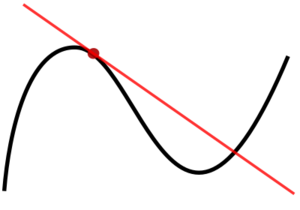Derivative (nonfiction): Difference between revisions
(Created page with "File:Slope_of_tangent_line_equal_to_derivative_of_function_at_marked_point.svg|thumb|The graph of a function, drawn in black, and a tangent line to that function, drawn in r...") |
No edit summary |
||
| (3 intermediate revisions by the same user not shown) | |||
| Line 1: | Line 1: | ||
[[File:Slope_of_tangent_line_equal_to_derivative_of_function_at_marked_point.svg|thumb|The graph of a function, drawn in black, and a tangent line to that function, drawn in red. The slope of the tangent line is equal to the derivative of the function at the marked point.]]The '''derivative''' of a [[ | [[File:Slope_of_tangent_line_equal_to_derivative_of_function_at_marked_point.svg|thumb|The graph of a function, drawn in black, and a tangent line to that function, drawn in red. The slope of the tangent line is equal to the derivative of the function at the marked point.]]The '''derivative''' of a [[Function of a real variable (nonfiction)|function of a real variable]] measures the sensitivity to change of the function value (output value) with respect to a change in its argument (input value). | ||
Derivatives are a fundamental tool of [[Calculus (nonfiction)|calculus]]. For example, the derivative of the position of a moving object with respect to time is the object's velocity: this measures how quickly the position of the object changes when time advances. | |||
The derivative of a function of a single variable at a chosen input value, when it exists, is the slope of the tangent line to the graph of the function at that point. The tangent line is the best linear approximation of the function near that input value. For this reason, the derivative is often described as the "instantaneous rate of change", the ratio of the instantaneous change in the dependent variable to that of the independent variable. | The derivative of a function of a single variable at a chosen input value, when it exists, is the slope of the tangent line to the graph of the function at that point. The tangent line is the best linear approximation of the function near that input value. For this reason, the derivative is often described as the "instantaneous rate of change", the ratio of the instantaneous change in the dependent variable to that of the independent variable. | ||
| Line 14: | Line 16: | ||
* [[Crimes against mathematical constants]] | * [[Crimes against mathematical constants]] | ||
* [[Gnomon algorithm]] | |||
* [[Gnomon Chronicles]] | |||
* [[Mathematics]] | * [[Mathematics]] | ||
| Line 19: | Line 23: | ||
* [[Calculus (nonfiction)]] | * [[Calculus (nonfiction)]] | ||
* [[Second derivative (nonfiction)]] | |||
* [[Third derivative (nonfiction)]] | |||
* [[Function of a real variable (nonfiction)]] | |||
* [[Mathematics (nonfiction)]] | * [[Mathematics (nonfiction)]] | ||
Latest revision as of 18:39, 4 January 2019
The derivative of a function of a real variable measures the sensitivity to change of the function value (output value) with respect to a change in its argument (input value).
Derivatives are a fundamental tool of calculus. For example, the derivative of the position of a moving object with respect to time is the object's velocity: this measures how quickly the position of the object changes when time advances.
The derivative of a function of a single variable at a chosen input value, when it exists, is the slope of the tangent line to the graph of the function at that point. The tangent line is the best linear approximation of the function near that input value. For this reason, the derivative is often described as the "instantaneous rate of change", the ratio of the instantaneous change in the dependent variable to that of the independent variable. Derivatives may be generalized to functions of several real variables. In this generalization, the derivative is reinterpreted as a linear transformation whose graph is (after an appropriate translation) the best linear approximation to the graph of the original function. The Jacobian matrix is the matrix that represents this linear transformation with respect to the basis given by the choice of independent and dependent variables. It can be calculated in terms of the partial derivatives with respect to the independent variables. For a real-valued function of several variables, the Jacobian matrix reduces to the gradient vector.
The process of finding a derivative is called differentiation. The reverse process is called antidifferentiation. The fundamental theorem of calculus states that antidifferentiation is the same as integration. Differentiation and integration constitute the two fundamental operations in single-variable calculus.
In the News
Fiction cross-reference
Nonfiction cross-reference
- Calculus (nonfiction)
- Second derivative (nonfiction)
- Third derivative (nonfiction)
- Function of a real variable (nonfiction)
- Mathematics (nonfiction)
External links:
- Derivative @ Wikipedia
